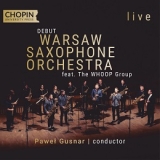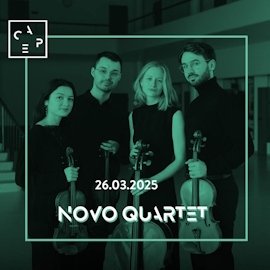Dies ist das Debütalbum des Warschauer Saxophonorchesters unter der Leitung seines Gründers Pawel Gusnar. Das Ensemble setzt sich aus Studenten und Absolventen der Saxophonklasse der Fryderyk-Chopin-Musikhochschule zusammen. Die Aufnahme zeigt das hohe technische Niveau des Orchesters sowie die klanglichen und koloristischen Möglichkeiten des Saxophonkollektivs.
Das Repertoire des Albums besteht aus Transkriptionen und Bearbeitungen von in der Orchesterliteratur etablierten Kompositionen (Beethoven, Mussorgsky und Kilar) – mehr oder weniger gut arrangiert von den Orchestermitgliedern Jakub Muras, Karol Mastalerz und Pawel Gusnar -, einer Suite aus populären Filmmotiven, arrangiert von Krzysztof Koszowski, und der Uraufführung eines eigens für das Ensemble geschriebenen Stücks von Wojciech Chalupka. Im letzten Stück, Gershwins Rhapsody in Blue, wird der Solistenpart von dem Saxophonquartett The Whoop bestritten.
Die Transkription der Beethoven-Tänze ist bestens gelungen und ergibt Mehrwert durch das makellose Spiel des Orchesters. Bei Mussorgskys Eine Nacht auf dem Kahlen Berg fehlt es an Fülle und Kraft. Das originale Stück Nyx von Wojciech Chalupka ist rhythmisch drängend und verlangt vom Orchester wie auch den solistisch hervortretenden Saxophonisten höchste Virtuosität. Das Orchester spielt spannungsvoll und mit spürbarer Begeisterung für diese tolle Musik.
Wojciech Kilars 1986 entstandenes Orawa wurde original für Streicher komponiert. Orawa ist der polnische Name eines Flusses in der Slowakei, der durchs Tatra-Gebirge fließt. Die Transkription für 12 Saxophone muss man als äußerst erfolgreich bezeichnen. Rhythmik und Farben bringen klar und deutlich Kilars Assoziationen an einen musikalischen Fluss zum Ausdruck.
In Koszowskis Movie Music Medley gibt es Themen aus Star Wars, The Lord of the Rings, The Simpsons, Jurassic Parc, Schindler’s List, Harry Potter u.a.
Die für Saxophon Quartett und Saxophonorchester arrangierte Fassung von Rhapsody in Blue will mir nicht gefallen. Der verspielte Ansatz gibt der Musik einen unnatürlichen und manierierten Rokoko-Charakter, der mit dem amerikanischen Jazz Age-Konzert nicht mehr gemein hat.
This is the debut album of the Warsaw Saxophone Orchestra under the direction of its founder Pawel Gusnar. The ensemble is composed of students and graduates of the saxophone class of the Fryderyk Chopin Academy of Music.
The recording shows the high technical level of the orchestra as well as the tonal and coloristic possibilities of the saxophone collective.
The album’s repertoire consists of transcriptions and arrangements of compositions established in the orchestral literature (Beethoven, Mussorgsky and Kilar) – arranged more or less well by orchestra members Jakub Muras, Karol Mastalerz and Pawel Gusnar -, a suite of popular film motifs arranged by Krzysztof Koszowski, and the world premiere of a piece written especially for the ensemble by Wojciech Chalupka. In the last piece, Gershwin’s Rhapsody in Blue, the soloist part is performed by The Whoop saxophone quartet.
The transcription of Beethoven’s dances is well done and results in added value from the flawless playing of the orchestra. Mussorgsky’s A Night on Bald Mountain lacks fullness and power. The original piece Nyx by Wojciech Chalupka is rhythmically urgent and demands the highest virtuosity from the orchestra as well as from the soloist saxophonists. The orchestra plays excitingly and with noticeable enthusiasm for this great music.
Wojciech Kilar’s Orawa, written in 1986, was originally composed for strings. Orawa is the Polish name of a river in Slovakia that flows through the Tatra Mountains. The transcription for 12 saxophones must be considered extremely successful. Rhythm and colors clearly express Kilar’s associations with a musical river.
Koszowski’s Movie Music Medley features themes from Star Wars, The Lord of the Rings, The Simpsons, Jurassic Parc, Schindler’s List, Harry Potter and others.
I don’t want to like the version of Rhapsody in Blue arranged for saxophone quartet and saxophone orchestra. The playful approach gives the music an unnatural and mannered rococo character that has nothing in common with the American Jazz Age concerto.






















